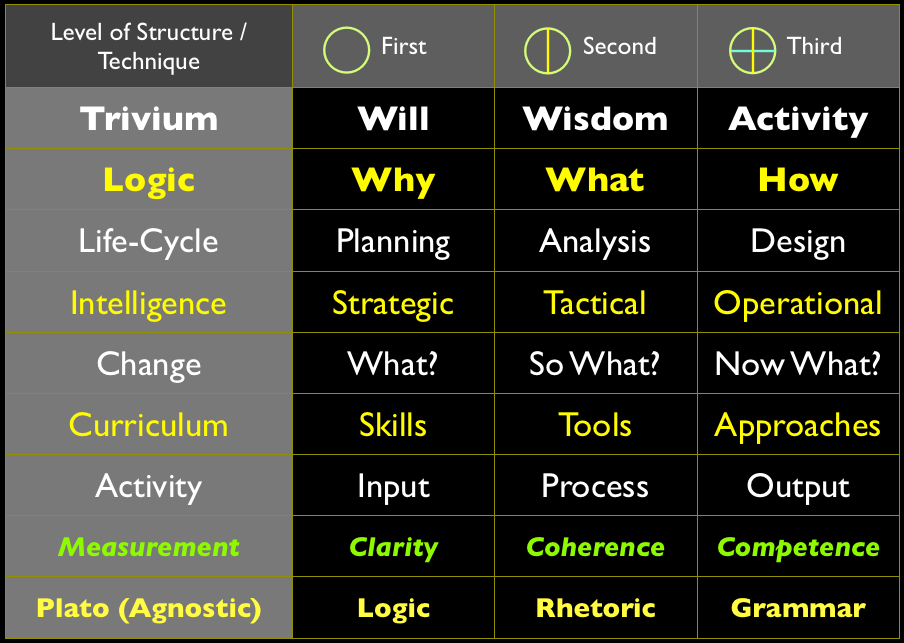The rule of thirds helps guide the facilitator and meeting designer. The Project Management Institute (PMI) refers to planning, analysis, and design as separate stages across a project or product development.
At ground level, the basic Use Case refers to Input>Process>Output as the basis for understanding requirements. Many of the world’s great religions of philosophy embrace the concept of a trinity. From Shiva, Vishnu, and Brahma of Hinduism to the great agnostic Plato, who referred to logic, rhetoric, and grammar as the trivium; testing of which allowed citizens to vote.
The Trivium
As elementary students, we learned the importance and proper sequencing of WHY before WHAT before HOW.
Let’s look at two components of Goldblatt’s Theory of Constraints (aka Triple Constraint Theory), namely time and quality.
Time
Optimally allow at least one hour of preparation time for each hour of meeting or workshop time. Early in the role of facilitator, as you develop your experience, competencies, and body of knowledge, the ratio can be much higher. Many suggest a practical ratio of two hours of preparation to every one hour of meeting or workshop time. The less familiar you are with the agenda and the tools you plan to use, the larger the ratio you can estimate.
Unfortunately, people forget the importance of the back-end as well; namely, what to do and invest after the meeting or workshop. Please make certain that your documentation is complete, and that it sizzles. Frequently the only residue of value left after a meeting or workshop is the document, and if it was not documented, it did not happen.
Take time to add context, typically cut and paste from your annotated agenda if thoroughly constructed. Context provides the background and rationale, the WHY, behind WHAT gets done during the meeting.
For example, take a decision made by a group to the executive sponsor or decision review board and their first question is WHY. Why did you make that decision? Let us be careful to document the rationale, the BECAUSE, behind the various components within a deliverable. Explain why they were built, how they relate to each other, and how they accelerate the project your meeting supports.
Quality
PMI refers to it as “front-end loading”, in other words, do not underinvest in the planning and building consensus around WHY something is important. For example, why do perform this function, process, or activity? Why we do something dramatically affects what we will do to support it.
Note the difference between a primary residence to raise a family and a beach house or camp hut used for family vacations. The purpose alone dictates different decisions and designs. A family vacation house for example may emphasize more beds than privacy, or give the family room more space while minimizing the study or library.
Even during a meeting, make sure you include a beginning, a middle, and an end. All too frequently, meetings fail to include one of them. Most people would rather go to a movie than a meeting because even a poor movie has a beginning, a middle, and an end. Do not discount the value of an effective review and wrap, and see Four Activities to Efficiently and Effectively Wrap-up a Meeting to manage the end, better than most.
______
Don’t ruin your career by hosting bad meetings. Sign up for a workshop or send this to someone who should. MGRUSH workshops focus on meeting design and practice. Each person practices tools, methods, and activities every day during the week. Therefore, while some call this immersion, we call it the road to building high-value facilitation skills.
Our workshops also provide a superb way to earn up to 40 SEUs from the Scrum Alliance, 40 CDUs from IIBA, 40 Continuous Learning Points (CLPs) based on Federal Acquisition Certification Continuous Professional Learning Requirements using Training and Education activities, 40 Professional Development Units (PDUs) from SAVE International, as well as 4.0 CEUs for other professions. (See workshop and Reference Manual descriptions for details.)
Want a free 10-minute break timer? Sign up for our once-monthly newsletter HERE and receive a timer along with four other of our favorite facilitation tools, free.

Terrence Metz, president of MG RUSH Facilitation Training, was just 22-years-old and working as a Sales Engineer at Honeywell when he recognized a widespread problem—most meetings were ineffective and poorly led, wasting both time and company resources. However, he also observed meetings that worked. What set them apart? A well-prepared leader who structured the session to ensure participants contributed meaningfully and achieved clear outcomes.
Throughout his career, Metz, who earned an MBA from Kellogg (Northwestern University) experienced and also trained in various facilitation techniques. In 2004, he purchased MG RUSH where he shifted his focus toward improving established meeting designs and building a curriculum that would teach others how to lead, facilitate, and structure meetings that drive results. His expertise in training world-class facilitators led to the 2020 publication of Meetings That Get Results: A Guide to Building Better Meetings, a comprehensive resource on effectively building consensus.
Grounded in the principle that “nobody is smarter than everybody,” the book details the why, what, and how of building consensus when making decisions, planning, and solving problems. Along with a Participant’s Guide and supplemental workshops, it supports learning from foundational awareness to professional certification.
Metz’s first book, Change or Die: A Business Process Improvement Manual, tackled the challenges of process optimization. His upcoming book, Catalyst: Facilitating Innovation, focuses on meetings and workshops that don’t simply end when time runs out but conclude with actionable next steps and clear assignments—ensuring progress beyond discussions and ideas.




